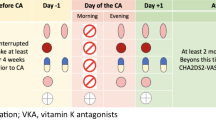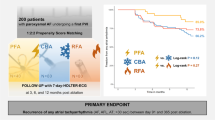Abstract
Background
Pulmonary vein (PV) reconnection after radiofrequency (RFC) or cryoballoon (CB) pulmonary vein isolation (PVI) is common.
Method
We report a single-center experience of 156 patients who underwent a redo procedure-ablation strategy for recurrent atrial fibrillation (AF) in a reverse sequence after a failed index RFC or CB PVI.
Results
A total of 60 patients after index CB PVI underwent RFC-redo ablation (CB-RFC redo), and 96 patients after index RFC PVI underwent CB-redo ablation (RFC-CB redo). During the redo procedure, the proportion of patients with PV reconnection was lower after index CB PVI procedure compared with the proportion of patients after index RFC PVI (88.3% versus 98.9%, p = 0.01). Additionally, a mean number of 1.50 ± 0.8 PVs/patient were reconnected after index CB PVI, compared with 3.36 ± 0.9 PVs/patient after index RFC PVI (p = 0.001). Patients after index RFC PVI frequently presented with ≥ 3 reconnected PVs, compared with index CB PVI (70.8% vs 10%, p < 0.001). At a 2-year follow-up, 43 patients (27.6%) developed recurrence after redo ablation, with a similar AF-free outcome (CB-RFC redo:73.3% vs RFC-CB redo: 71.9%, p = 0.873). In the multivariate analysis, persistent AF (HR = 2.107, 95% CI: 1.085–4.091, p = 0.028) and early AF recurrence after the initial ablation (HR = 2.431, 95% CI: 1.279–4.618, p = 0.007) were independent predictors of AF recurrence.
Conclusions
The extent and distribution of PV reconnections were different after index RFC and CB PVI procedures. Alternating CB or RFC ablation technique strategy is effective with a similar long-term outcome, and it may be an appropriate option for repeated AF ablation.





Similar content being viewed by others
Abbreviations
- AF:
-
Atrial fibrillation
- LA:
-
Left atrial
- LVEF:
-
Left ventricular ejection fraction
- LAD:
-
Left atrial diameter
- RFC:
-
Radiofrequency catheter ablation
- CB:
-
Cryoballoon
- HR:
-
Hazard ratio
- PV:
-
Pulmonary vein
- CTs:
-
Left common trunk(s)
- LAA:
-
Left atrial appendage
- LSPV(s):
-
Left superior pulmonary vein(s)
- LIPV(s):
-
Left inferior pulmonary vein(s)
- RSPV(s):
-
Right superior pulmonary vein(s)
- RIPV(s):
-
Right inferior pulmonary vein(s)
References
Heeringa J, van der Kuip DA, Hofman A, Kors JA, van Herpen G, Stricker BH, et al. Prevalence, incidence and lifetime risk of atrial fibrillation: the Rotterdam study. Eur Heart J. 2006;27:949–53.
Buist TJ, Adiyaman A, Smit JJJ, Ramdat Misier AR, Elvan A. Arrhythmia-free survival and pulmonary vein reconnection patterns after second-generation cryoballoon and contact-force radiofrequency pulmonary vein isolation. Clin Res Cardiol. 2018;107:498–506.
Ang R, Rj Hunter WY, Lim A Opel, Ullah W, Providencia R, Baker V, Finlay MC, Dhinoja MB, Early MJ, Schilling RJ. Long term outcome and pulmonary vein reconnection of patients undergoing cryoablation and/or radiofrequency ablation: results from the cryo versus RF trial. J Atr Fibrillation. 2018;11(3):2072.
Ciconte G, Velagić V, Mugnai G, Saitoh Y, Irfan G, Hunuk B, et al. Electrophysiological findings following pulmonary vein isolation using radiofrequency catheter guided by contact-force and second generation cryoballoon: lessons from repeat ablation procedures. Europace. 2016;18:71–7.
Kuck KH, Brugada J, Fürnkranz A, Metzner A, Ouyang F, Chun KR, FIRE AND ICE Investigators, et al. Cryoballoon or radiofrequency ablation for paroxysmal atrial fibrillation. N Engl J Med. 2016;374(23):2235–45.
Kuck KH, Fürnkranz A, Chun KR, Fürnkranz A, Busch M, Elvan A, FIRE AND ICE Investigators, et al. Cryoballoon or radiofrequency ablation for symptomatic paroxysmal atrial fibrillation: reintervention, rehospitalization, and quality-of-life outcomes in the FIRE and ICE trial. Eur Heart J. 2016;37(38):2858–65.
Hussein AA, Saliba WI, Martin DO, Bhargava M, Sherman M, Magnelli-Reyes C, et al. Natural history and long-term outcomes of ablated atrial fibrillation. Circ Arrhythm Electrophysiol. 2011;4:271–8.
Wieczorek M, Sassani K, Hoeltgen R. Comparison of pulmonary vein reconnection patterns after multielectrode phased radiofrequency- and cryoballoon ablation of atrial fibrillation. BMC Cardiovasc Disord. 2020;20(1):197.
Verlato R, Pieragnoli P, Iacopino S, Rauhe W, Molon G, Stabile G, et al. Cryoballoon or radiofrequency ablation? Alternating technique for repeat procedures in patients with atrial fibrillation. Pacing Clin Electrophysiol. 2020;43(7):687–97.
Shah S, Xu W, Adelstein E, Voigt A, Saba S, Jain S. Characterization of pulmonary vein reconnection post cryoballoon ablation. Indian Pacing Electrophysiol J. 2019;19(4):129–33.
Miyazaki S, Taniguchi H, Hachiya H, Nakamura H, Takagi T, Iwasawa J, et al. Quantitative analysis of the isolation area during the chronic phase after a 28-mm second-generation cryoballoon ablation demarcated by high-resolution electroanatomic mapping. Circ Arrhythm Electrophysiol. 2016;9: e003879.
Daimee UA, Akhtar T, Boyle TA, Jager L, Arbab-Zadeh A, Marine JE, et al. Repeat catheter ablation for recurrent atrial fibrillation: electrophysiologic findings and clinical outcomes. J Cardiovasc Electrophysiol. 2021;32(3):628–38.
Balt JC, Karadavut S, Mulder AA, Luermans JG, Wijffels MC, Boersma LV. Conduction recovery in patients with recurrent atrial fibrillation after pulmonary vein isolation using multi-electrode duty cycled radiofrequency ablation. J Intervent Cardiac Electrophysiol. 2013;37(2):197–204.
Aryana A, Singh SM, Mugnai G, de Asmundis C, Kowalski M, Pujara DK, et al. Pulmonary vein reconnection following catheter ablation of atrial fibrillation using the second-generation cryoballoon versus open-irrigated radiofrequency: results of a multicenter analysis. J Intervent Cardiac Electrophysiol. 2016;47(3):341–8.
Ho SY, Sanchez-Quintana D, Cabrera JA, Anderson RH. Anatomy of the left atrium: implications for radiofrequency ablation of atrial fibrillation. J Cardiovasc Electrophysiol. 1999;10:1525–33.
le Polain de Waroux JB, Weerasooriya R, Anvardeen K, Barbraud C, Marchandise S, De Meester C, et al. Low contact force and force-time integral predict early recovery and dormant conduction revealed by adenosine after pulmonary vein isolation. Europace. 2015;pii:euu329.
Munkler P, Kroger S, Liosis S, Abdin A, Lyan E, Eitel C, et al. Ablation index for catheter ablation of atrial fibrillation- clinical applicability and comparison with force-time integral. Circ J. 2018;82:2722–7.
Reddy VY, Neuzil P, Koruth JS, Petru J, Funosako M, Cochet H, et al. Pulsed field ablation for pulmonary vein isolation in atrial fibrillation. J Am Coll Cardiol. 2019;74(3):315–26.
Wakamatsu Y, Nakahara S, Nagashima K, Fukuda R, Nishiyama N, Watanabe R, et al. Hot balloon versus cryoballoon ablation for persistent atrial fibrillation: lesion area, efficacy, and safety. J Cardiovasc Electrophysiol. 2020;31(9):2310–8.
Miyazaki S, Kajiyama T, Watanabe T, Hada M, Nakamura H, Hachiya H, et al. Impact of electrical connections between ipsilateral pulmonary veins on the second-generation cryoballoon ablation procedure. J Cardiovasc Electrophysiol. 2019;30(1):27–31.
Ströker E, Takarada K, de Asmundis C, Abugattas JP, Mugnai G, Velagic V, et al. Second-generation cryoballoon ablation in the setting of left common pulmonary veins: procedural findings and clinical outcome. Heart Rhythm. 2017;14:1311–8.
Beiert T, Lodde PC, Linneborn LPT, Werner J, Prinz L, Stöckigt F, et al. Outcome in patients with left common pulmonary vein after cryoablation with second-generation cryoballoon. Pacing Clin Electrophysiol. 2018;41(1):22–7.
Heeger CH, Wissner E, Mathew S, Deiss S, Lemes C, Rillig A, et al. Once Isolated, always isolated? Incidence and characteristics of pulmonary vein reconduction after second-generation cryoballoon-based pulmonary vein isolation. Circ Arrhythm Electrophysiol. 2015;8(5):1088–94.
Chen S, Schmidt B, Bordignon S, Bologna F, Nagase T, Perrotta L, et al. Practical techniques in cryoballoon ablation: how to isolate inferior pulmonary veins. Arrhythm Electrophysiol Rev. 2018;7(1):11–7.
Anic A, Lever N, Martin A, Breskovic T, Sulkin MS, Duffy E, et al. Acute safety, efficacy, and advantages of a novel cryoballoon ablation system for pulmonary vein isolation in patients with paroxysmal atrial fibrillation: initial clinical experience. Europace. 2021;23(8):1237–43.
Reddy VY, Sediva L, Petru J, Skoda J, Chovanec M, Chitovova Z, et al. Durability of pulmonary vein isolation with cryoballoon ablation: results from the sustained PV Isolation with Arctic Front Advance (SUPIR) Study. J Cardiovasc Electrophysiol. 2015;26:493–500.
Miao C, Ju W, Chen H, Yang G, Zhang F, Gu K, et al. Clinical and electrophysiological characteristics predicting the re-ablation outcome for atrial fibrillation patients. J Interv Card Electrophysiol. 2020;59:373–9.
Glowniak A, Tarkowski A, Fic P, Wojewoda K, Wojcik J, Wysokinski A. Second-generation cryoballoon ablation for recurrent atrial fibrillation after an index procedure with radiofrequency versus cryo: different pulmonary vein reconnection patterns but similar long-term outcome-Results of a multicenter analysis. J Cardiovasc Electrophysiol. 2019;30(7):1005–12.
Lee JM, Shim J, Park J, Yu HT, Kim TH, Park JK, POBI-AF Investigators, et al. The electrical isolation of the left atrial posterior wall in catheter ablation of persistent atrial fibrillation. JACC Clin Electrophysiol. 2019;5(11):1253–61.
Verma A, Jiang CY, Betts TR, Chen J, Deisenhofer I, Mantovan R, et al. Approaches to catheter ablation for persistent atrial fibrillation. N Engl J Med. 2015;372(19):1812–22.
Funding
This study was supported by the National Natural Science Foundation of China (No.81670309).
Author information
Authors and Affiliations
Corresponding author
Ethics declarations
Compliance with ethical standards
The retrospective study was approved by the Ethics Committee of the Fuwai Hospital (No. 2016–829) according to the Helsinki Declaration.
Consent to participate
Written informed consent was provided by all participants or their legal guardians. All methods were performed in accordance with the relevant guidelines and regulations of the Declaration of Helsinki.
Competing interests
The authors declare no competing interests.
Additional information
Publisher's note
Springer Nature remains neutral with regard to jurisdictional claims in published maps and institutional affiliations.
Rights and permissions
Springer Nature or its licensor holds exclusive rights to this article under a publishing agreement with the author(s) or other rightsholder(s); author self-archiving of the accepted manuscript version of this article is solely governed by the terms of such publishing agreement and applicable law.
About this article
Cite this article
Tang, Qh., Guo, XG. & Ma, J. A novel alternating second-generation cryoballoon or contact-force guided radiofrequency catheter ablation strategy for redo-ablation in patients with recurrent atrial fibrillation: a single-center experience. J Interv Card Electrophysiol 65, 739–750 (2022). https://doi.org/10.1007/s10840-022-01321-x
Received:
Accepted:
Published:
Issue Date:
DOI: https://doi.org/10.1007/s10840-022-01321-x




